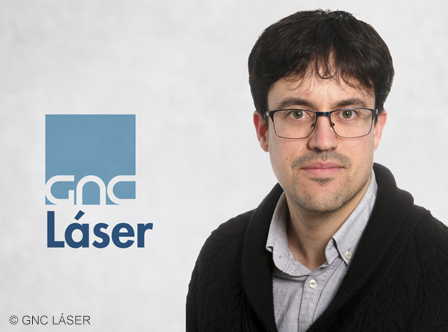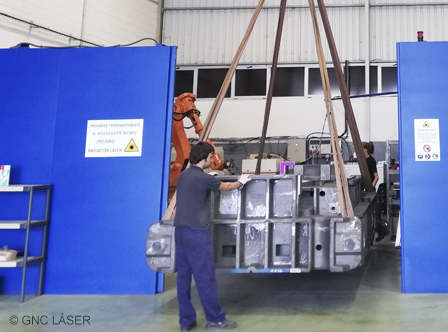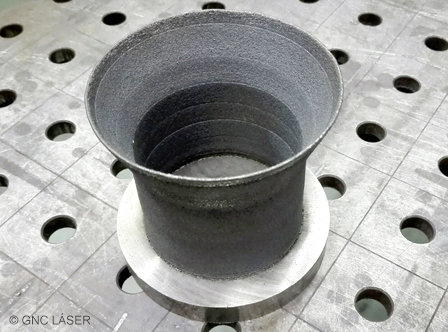INTERVIEW



For the last 11 years, the Guipuzkoan company GNC Láser has been specialising in the use of high power lasers in its advanced manufacturing sector. Since he joined GNC Láser in 2012, Hasier Orbegozo has undertaken many roles at the organisation and currently heads up the company’s technology division. In this interview, Orbegozo highlights the industry-wide spike in interest in laser technology and the processes which stem from it.
1.- What are the principal industrial applications for high power laser technology which are being developed at GNC Láser and what advantages do they bring compared to traditional manufacturing methods?
Last year GNC Láser celebrated 10 years since it started trading, and since the outset of its journey it has offered high power laser services such as soldering, hardening and cladding across the whole industrial network. Although, at the beginning, its profile was that of a company offering services which were of high technological value and clearly aimed at the processing of metallic materials, these days it has evolved and has opened up new lines of business.
First of all, foundations are being laid for the integration of cells based on laser operations. Secondly, there is a clear commitment to the additive manufacturing of metallic components using the cladding/LMD (Laser Metal Deposition) technique, not forgetting the SLM (Sintering Laser Melting) process. Lastly, we are responsible for the supply of complete components, whose added value is based on laser technology, incorporating or outsourcing other auxiliary operations. For example, at the moment we supply on a daily basis an automotive component whose main operation is scanner or non-contact soldering.
One of the main advantages of this technology across its various processes is a reduced energy input to the processed part due to the super focalisation of the laser beam.
This benefit is one of the competitive strengths in, for example, laser hardening; a process in which it is possible to minimise the deformities and residual tensions resulting from heat treatment, reducing problems and post-processing in comparison with other techniques, such as induction.
Laser cladding involves the deposition of high performance materials (inconel, stellite, tungsten carbide particles on metal matrix, stainless steels) seeking, through the reinforcing of critical areas, to increase tool life and improve component behaviour etc. In this case, the high energy focus of the laser facilitates low dilution and heat transfer to the substrate, which can be critical in many situations and lead to embrittlement and the appearance of cracks.
It’s also worth mentioning that laser technology enables high levels of automation, being that it is very competitive in high-volume assembly line production such as the soldering of automotive parts.
2.- What is the importance of R&D in the GNC Láser strategy?
Due to the technology which is at the heart of GNC Láser activity, R&D is fundamental to our growth. When the company started up, the little knowledge that existed in the field regarding high-power laser technology was to be found exclusively in technology centres and universities, so collaboration and participation in R&D projects has always been very much a part of our business.
What is more, the vast majority of work that we get presents a new and unknown element: new materials or a combination of dissimilar materials, improved processes with the development of new processing heads, etc.
In recent times our R&D efforts have been particularly focused on improving the laser cladding process in various aspects.
Another aspect which is being targeted at an internal level is the need to attain high TRLs, with a view to the project developments having a real and direct impact on the income statement in the not too long term.
For GNC Láser it is crucial to have the involvement of companies who bring their element to the project and who, should the project ultimately be successful, would be seeking a subcontracting company like ours.
3.- Can you describe the collaboration between GNC Láser and the IK4-TEKNIKER technology centre? What applications have you developed together?
IK4-TEKNIKER is one of the key technological partners for GNC Láser and our collaboration has spanned various fields and technologies.
I should mention, for example, the TRESCOMP project, in which GNC Láser, in collaboration with IK4-TEKNIKER, had made very interesting progress in the field of scanner-based laser hardening to counter the limitations of fixed-optic laser hardening techniques, which we have been working with since the creation of the company.
Our participation in the DEBACOAT project also stands out where again we collaborated with IK4-TEKNIKER in a project involving laser cladding materials with tungsten carbide particles.
GNC Láser has found a trusted technological partner in IK4-TEKNIKER: a partner with whom we have come full circle, starting with the technology centre and its respective viability study, then product development and/or improvement with laser technology as the central operation, leading latterly to our joining them as a partner to provide the industrial solution.
GNC Láser, in a great many scenarios, brings innovative technology to the table which is capable of replacing other more well-known examples. This implies a commitment to continual innovation, since very often much more is demanded of a substitute technology and because in many cases it modifies somewhat the manufacturing processes of the product.
4.- What are the main research trends in the field of laser technology for advanced manufacturing at the present moment?
In advanced manufacturing, lasers are a major factor in a field which is causing quite a stir: additive manufacturing, both in its powder bed technique or SLM and its trending LMD or laser cladding.
Due to our proximity to this second process, we have made substantial investigative efforts in fields such as the control process for working in closed loop, the development of new input materials or predictive behaviour software, achieving a digital wire through the whole process connecting design, predictive analysis, manufacturing and post-processing, etc.
Furthermore, there are different trends within the sector such as bids to hybridise the process, incorporating chip removal technology and additive manufacturing technology into the same system or machine.



